2021 Peugeot 308 ECU
[x] Cancel search: ECUPage 72 of 244
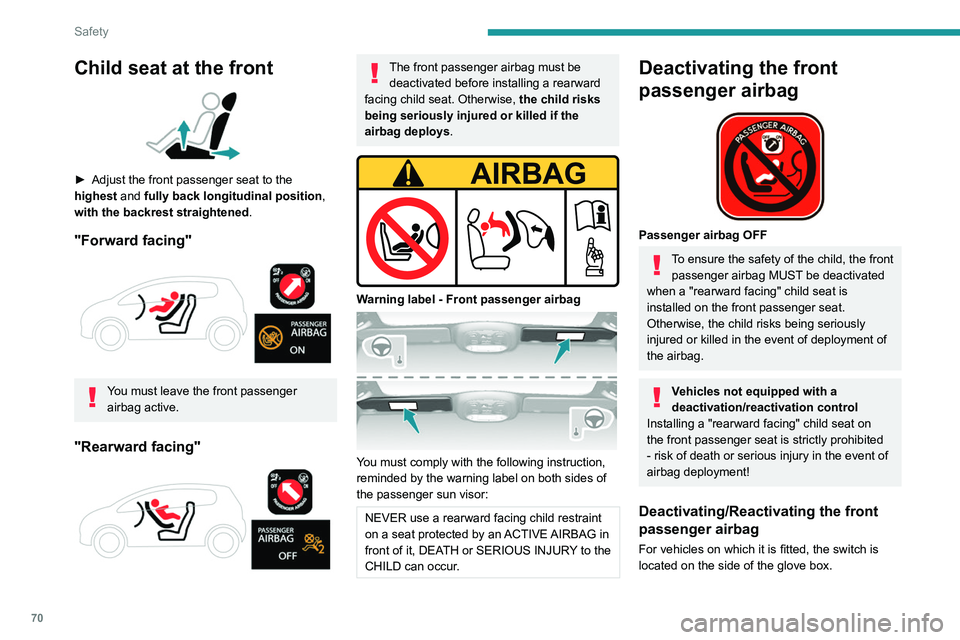
70
Safety
Child seat at the front
► Adjust the front passenger seat to the
highest and fully back longitudinal position ,
with the backrest straightened.
"Forward facing"
You must leave the front passenger airbag active.
"Rearward facing"
The front passenger airbag must be deactivated before installing a rearward
facing child seat. Otherwise, the child risks
being seriously injured or killed if the
airbag deploys.
Warning label - Front passenger airbag
You must comply with the following instruction,
reminded by the warning label on both sides of
the passenger sun visor:
NEVER use a rearward facing child restraint
on a seat protected by an ACTIVE AIRBAG in
front of it, DEATH or SERIOUS INJURY to the
CHILD can occur.
Deactivating the front
passenger airbag
Passenger airbag OFF
To ensure the safety of the child, the front passenger airbag MUST be deactivated
when a "rearward facing" child seat is
installed on the front passenger seat.
Otherwise, the child risks being seriously
injured or killed in the event of deployment of
the
airbag.
Vehicles not equipped with a
deactivation/reactivation control
Installing a "rearward
facing" child seat on
the front passenger seat is strictly prohibited
- risk of death or serious injury in the event of
airbag deployment!
Deactivating/Reactivating the front
passenger airbag
For vehicles on which it is fitted, the switch is
located on the side of the glove box.
With the ignition off:
► To deactivate the airbag, turn the key in the
switch to the "OFF " position.
► To reactivate it, turn the key to the "ON"
position.
When the ignition is switched on:
This warning lamp comes on and remains lit to signal deactivation.
Or
This warning lamp comes on for about 1 minute to signal activation.
Recommended child seats
Approved range of recommended child seats
secured using a three-point seat belt.
Page 73 of 244
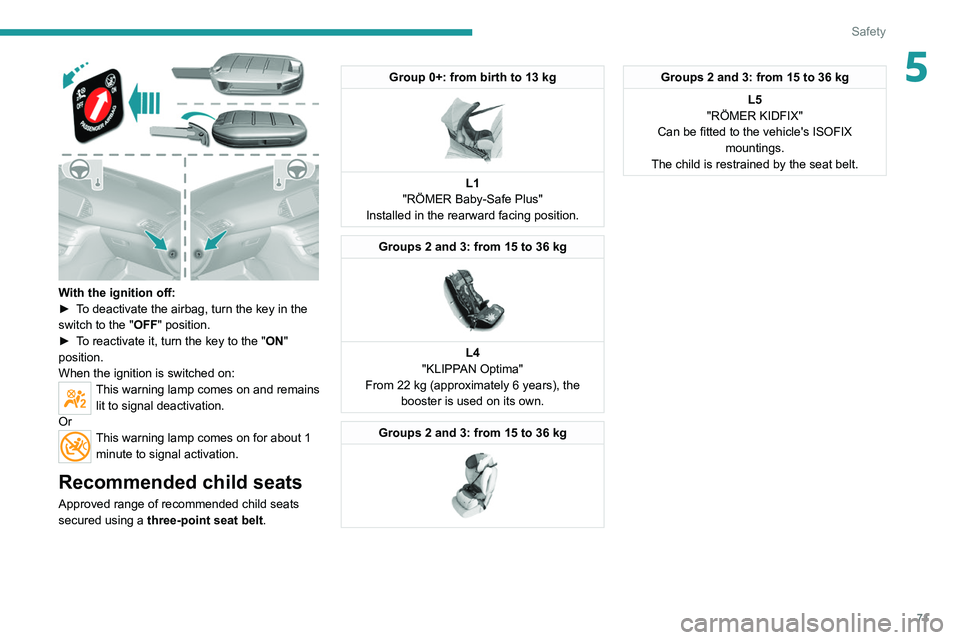
71
Safety
5
With the ignition off:
► T o deactivate the airbag, turn the key in the
switch to the "OFF " position.
►
T
o reactivate it, turn the key to the "ON"
position.
When the ignition is switched on:
This warning lamp comes on and remains lit to signal deactivation.
Or
This warning lamp comes on for about 1 minute to signal activation.
Recommended child seats
Approved range of recommended child seats
secured using a three-point seat belt.
Group 0+: from birth to 13 kg
L1
"RÖMER Baby-Safe Plus"
Installed in the rearward facing position.
Groups 2 and 3: from 15 to 36 kg
L4
"KLIPPAN Optima"
From 22 kg (approximately 6 years), the booster is used on its own.
Groups 2 and 3: from 15 to 36 kg
Groups 2 and 3: from 15 to 36 kg
L5
"RÖMER KIDFIX"
Can be fitted to the vehicle's ISOFIX mountings.
The child is restrained by the seat belt.
Page 74 of 244
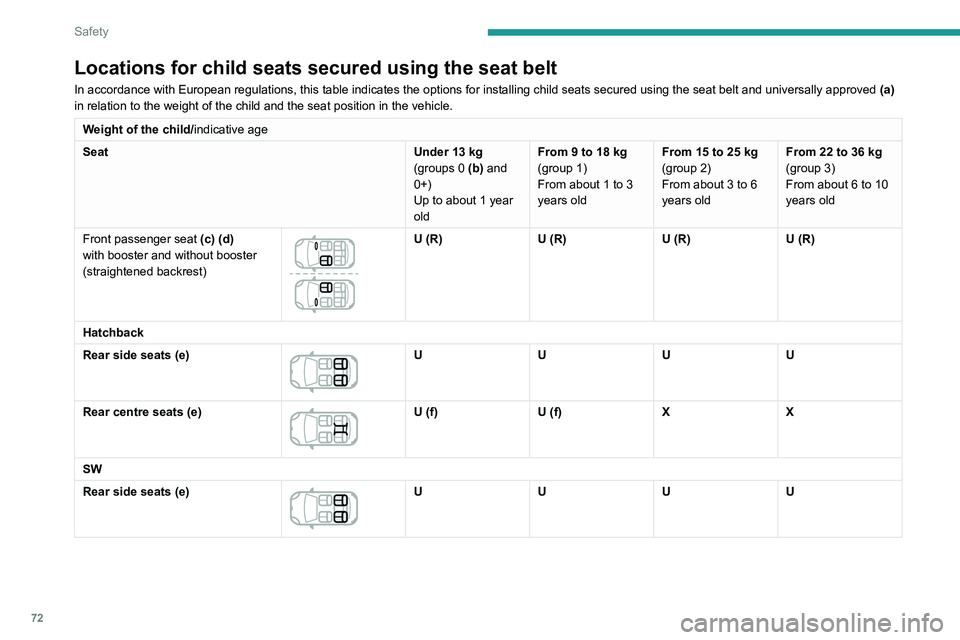
72
Safety
Locations for child seats secured using the seat belt
In accordance with European regulations, this table indicates the option\
s for installing child seats secured using the seat belt and universally\
approved (a)
in relation to the weight of the child and the seat position in the vehi\
cle.
Weight of the child/ indicative age
Seat Under 13
kg
(groups
0 (b) and
0+)
Up to about 1 year
old From 9 to 18
kg
(group 1)
From about 1 to 3
years old From 15 to 25
kg
(group 2)
From about 3 to 6
years old From 22 to 36
kg
(group 3)
From about 6 to 10
years old
Front passenger seat (c) (d)
with booster and without booster
(straightened backrest)
U (R) U (R)U (R)U (R)
Hatchback
Rear side seats (e)
U UUU
Rear centre seats (e)
U (f) U (f)XX
SW
Rear side seats (e)
U UUU
Page 75 of 244
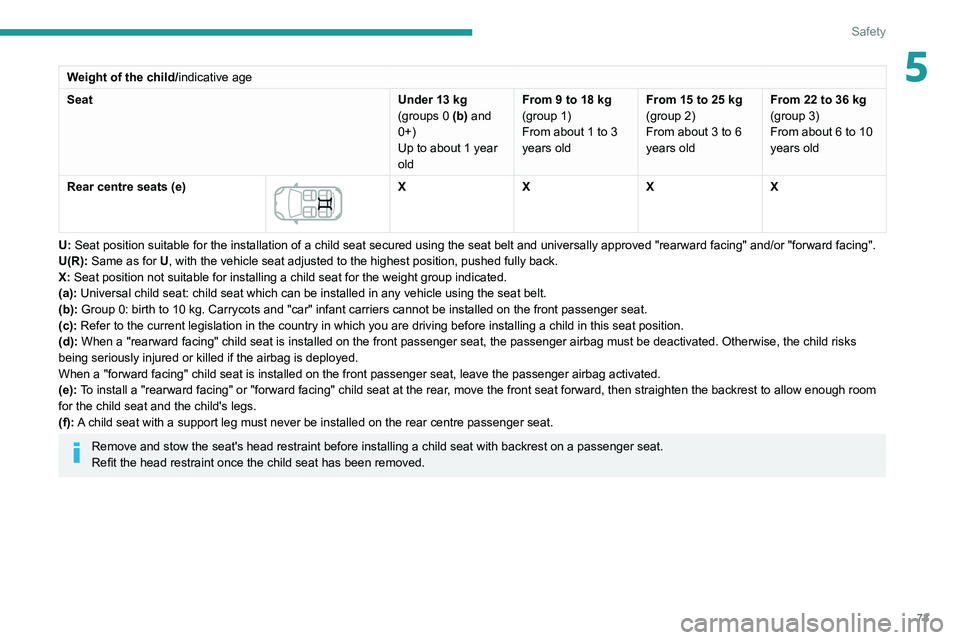
73
Safety
5Weight of the child/indicative age
Seat Under 13
kg
(groups
0 (b) and
0+)
Up to about 1 year
old From 9 to 18
kg
(group 1)
From about 1 to 3
years old From 15 to 25
kg
(group 2)
From about 3 to 6
years old From 22 to 36
kg
(group 3)
From about 6 to 10
years old
Rear centre seats
(e)
X XXX
U: Seat position suitable for the installation of a child seat secured usi\
ng the seat belt and universally approved "rearward facing" and/or "forw\
ard facing".
U(R): Same as for U, with the vehicle seat adjusted to the highest position, pushed fully b\
ack.
X: Seat position not suitable for installing a child seat for the weight g\
roup indicated.
(a): Universal child seat: child seat which can be installed in any vehicle \
using the seat belt.
(b): Group 0: birth to 10
kg. Carrycots and "car" infant carriers cannot be installed on the front\
passenger seat.
(c): Refer to the current legislation in the country in which you are drivin\
g before installing a child in this seat position.
(d): When a "rearward facing" child seat is installed on the front passenger\
seat, the passenger airbag must be deactivated. Otherwise, the child ri\
sks
being seriously injured or killed if the airbag is deployed.
When a "forward facing" child seat is installed on the front passenger s\
eat, leave the passenger airbag activated.
(e): To install a "rearward facing" or "forward facing" child seat at the rear\
, move the front seat forward, then straighten the backrest to allow eno\
ugh room
for the child seat and the child's legs.
(f): A child seat with a support leg must never be installed on the rear centr\
e passenger seat.
Remove and stow the seat's head restraint before installing a child seat\
with backrest on a passenger seat.
Refit the head restraint once the child seat has been removed.
Page 76 of 244
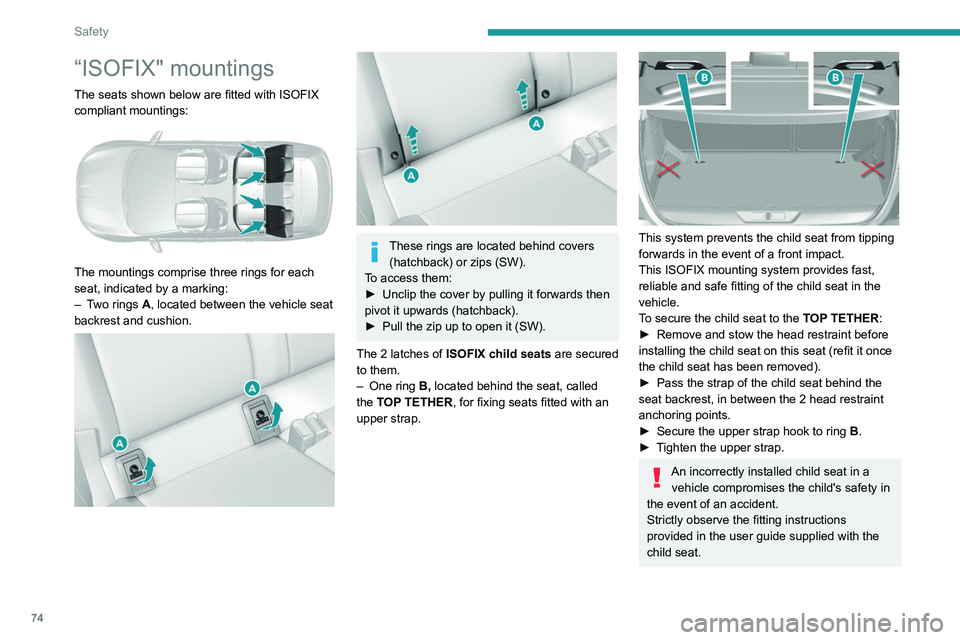
74
Safety
“ISOFIX" mountings
The seats shown below are fitted with ISOFIX
compliant mountings:
The mountings comprise three rings for each
seat, indicated by a marking:
–
T
wo rings A, located between the vehicle seat
backrest and cushion.
These rings are located behind covers (hatchback) or zips (SW).
To access them:
►
Unclip the cover by pulling it forwards then
pivot it upwards (hatchback).
►
Pull the zip up to open it (SW).
The 2
latches of ISOFIX child seats are secured
to them.
–
One ring
B, located behind the seat, called
the TOP TETHER, for fixing seats fitted with an
upper strap.
This system prevents the child seat from tipping
forwards in the event of a front impact.
This ISOFIX mounting system provides fast,
reliable and safe fitting of the child seat in the
vehicle.
To secure the child seat to the TOP TETHER:
►
Remove and stow the head restraint before
installing the child seat on this seat (refit it once
the child seat has been removed).
►
Pass the strap of the child seat behind the
seat backrest, in between the 2 head restraint
anchoring points.
►
Secure the upper strap hook to ring
B
.
►
T
ighten the upper strap.
An incorrectly installed child seat in a vehicle compromises the child's safety in
the event of an accident.
Strictly observe the fitting instructions
provided in the user guide supplied with the
child seat.
For information about the options for
fitting ISOFIX child seats in your vehicle,
refer to the summary table.
If your vehicle has a spare wheel of the same
size as the other four wheels, follow the
procedure below:
► pass the strap and spring hook over the boot
floor (in the slot),
► raise the boot floor,
► lift out the upper storage box, located
alongside the wheel,
► attach the spring hook to the TOP TETHER
ring,
► refit the storage box and boot floor.
Recommended ISOFIX child
seats
Also consult the user guide from the child
seat’s manufacturer to find out how to
install and remove the seat.
Page 77 of 244
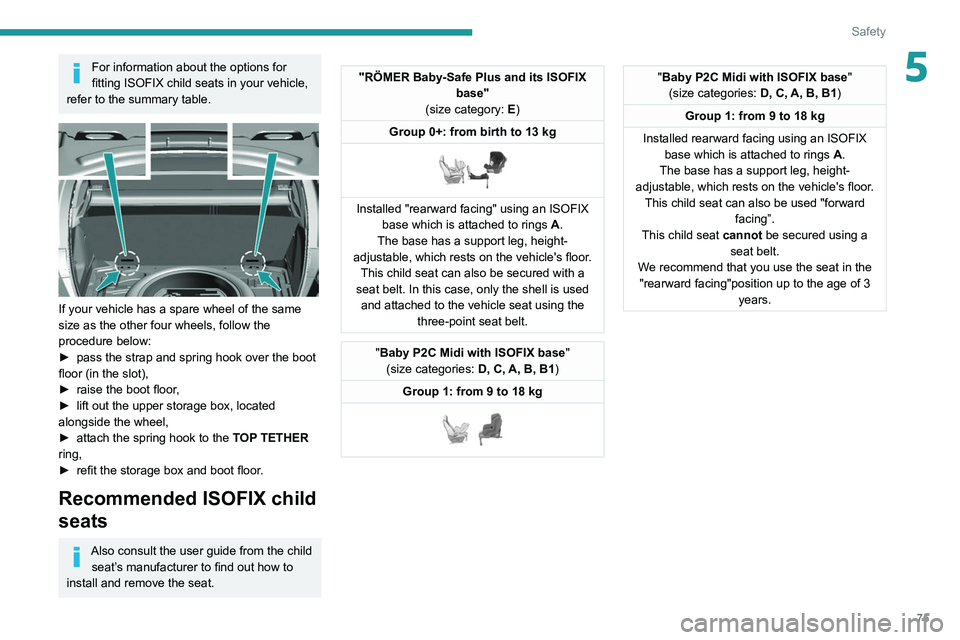
75
Safety
5For information about the options for
fitting ISOFIX child seats in your vehicle,
refer to the summary table.
If your vehicle has a spare wheel of the same
size as the other four wheels, follow the
procedure below:
►
pass the strap and spring hook over the boot
floor (in the slot),
►
raise the boot floor
,
►
lift out the upper storage box, located
alongside the wheel,
►
attach the spring hook to the
TOP TETHER
ring,
►
refit the storage box and boot floor
.
Recommended ISOFIX child
seats
Also consult the user guide from the child seat’s manufacturer to find out how to
install and remove the seat.
"RÖMER Baby-Safe Plus and its ISOFIX base"
(size category: E)
Group 0+: from birth to 13 kg
Installed "rearward facing" using an ISOFIX base which is attached to rings A .
The base has a support leg, height-
adjustable, which rests on the vehicle's floor. This child seat can also be secured with a
seat belt. In this case, only the shell is used and attached to the vehicle seat using the three-point seat belt.
"Baby P2C Midi with ISOFIX base "
(size categories: D, C, A, B, B1)
Group 1: from 9 to 18 kg
"Baby P2C Midi with ISOFIX base "
(size categories: D, C, A, B, B1)
Group 1: from 9 to 18 kg
Installed rearward facing using an ISOFIX base which is attached to rings A.
The base has a support leg, height-
adjustable, which rests on the vehicle's floor. This child seat can also be used "forward facing”.
This child seat cannot be secured using a seat belt.
We recommend that you use the seat in the "rearward facing"position up to the age of 3 years.
Page 78 of 244
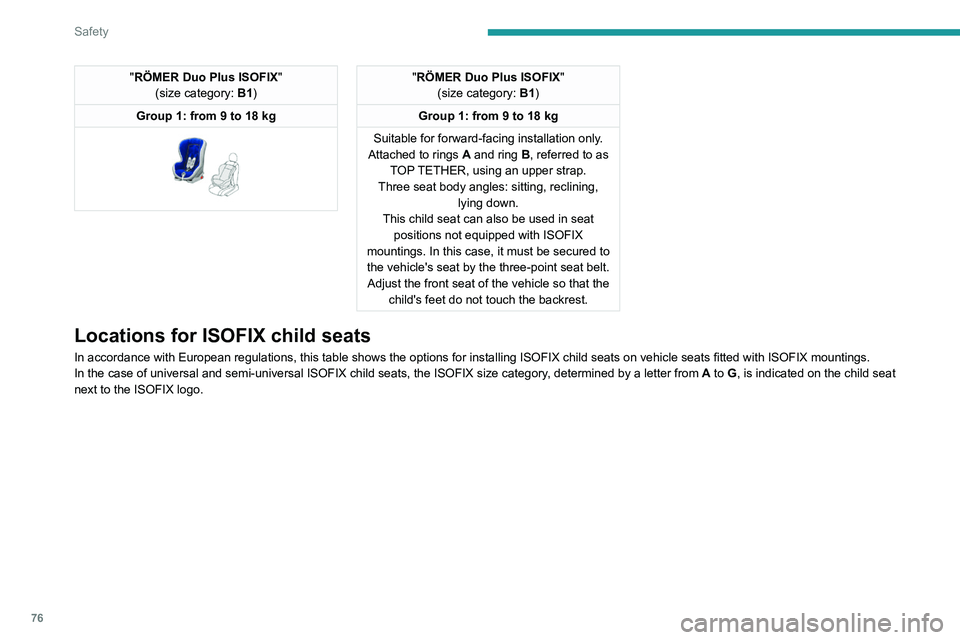
76
Safety
"RÖMER Duo Plus ISOFIX"
(size category: B1)
Group 1: from 9 to 18 kg
"RÖMER Duo Plus ISOFIX "
(size category: B1)
Group 1: from 9 to 18 kg
Suitable for forward-facing installation only.
Attached to rings
A and ring B, referred to as
TOP TETHER, using an upper strap.
Three seat body angles: sitting, reclining, lying down.
This child seat can also be used in seat positions not equipped with ISOFIX
mountings. In this case, it must be secured to the vehicle's seat by the three-point seat belt. Adjust the front seat of the vehicle so that the child's feet do not touch the backrest.
Locations for ISOFIX child seats
In accordance with European regulations, this table shows the options for installing ISOFIX child seats on vehicle seats fitted with ISOFIX mountings.
In the case of universal and semi-universal ISOFIX child seats, the ISOF\
IX size category, determined by a letter from A to G, is indicated on the child seat
next to the ISOFIX logo.
Page 80 of 244
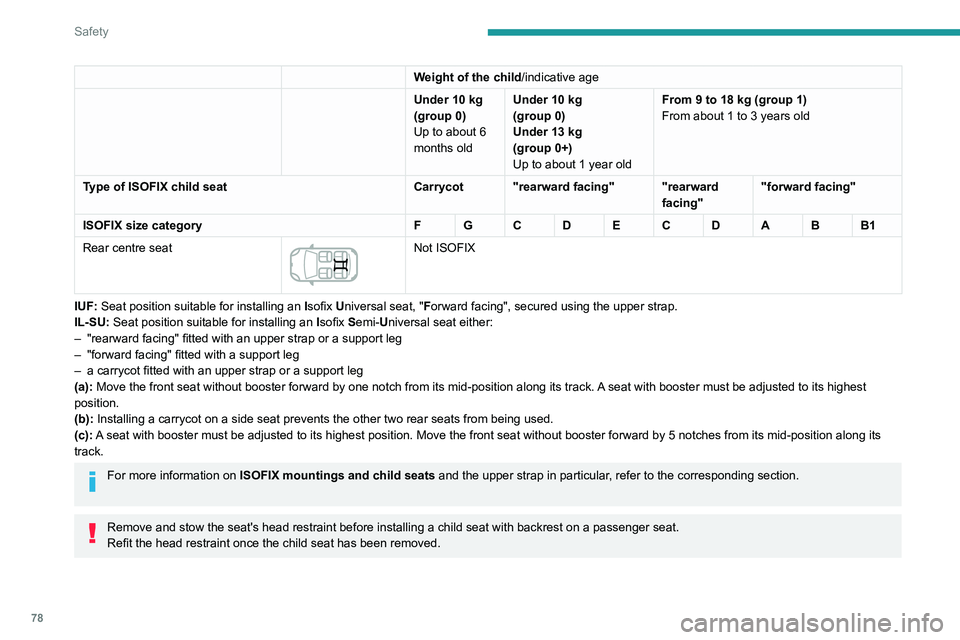
78
Safety
Weight of the child/indicative age
Under 10 kg
(group
0)
Up to about 6
months old Under 10
kg
(group
0)
Under 13
kg
(group
0+)
Up to about 1 year old From 9 to 18
kg (group 1)
From about 1 to 3 years old
Type of ISOFIX child seat Carrycot "rearward facing" "rearward
facing""forward facing"
ISOFIX size category F G C D E C D A B B1
Rear centre seat
Not ISOFIX
IUF: Seat position suitable for installing an Isofix Universal seat, "Forward facing", secured using the upper strap.
IL-SU: Seat position suitable for installing an Isofix Semi-Universal seat either:
–
"rearward facing" fitted with an upper strap or a support leg
–
"forward facing" fitted with a support leg
–
a carrycot fitted with an upper strap or a support leg
(a):
Move the front seat without booster forward by one notch from its mid-p\
osition along its track. A seat with booster must be adjusted to its highest
position.
(b): Installing a carrycot on a side seat prevents the other two rear seats \
from being used.
(c): A seat with booster must be adjusted to its highest position. Move the fr\
ont seat without booster forward by 5 notches from its mid-position alon\
g its
track.
For more information on ISOFIX mountings and child seats and the upper strap in particular, refer to the corresponding section.
Remove and stow the seat's head restraint before installing a child seat\
with backrest on a passenger seat.
Refit the head restraint once the child seat has been removed.
Child lock
This mechanical system prevents opening of a
rear door using its interior control.
The control is located on the edge of each rear
door and locking is independent for each door.
Locking
► Using the built-in key, turn the control as far
as it will go: • to the left on the left-hand rear door,
• to the right on the right-hand rear door.
Unlocking
► Using the built-in key, turn the control as far
as it will go: • to the right on the left-hand rear door,
• to the left on the right-hand rear door.